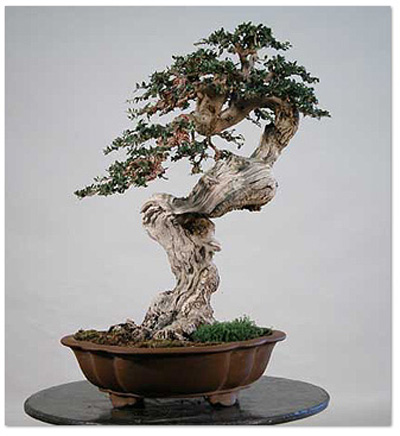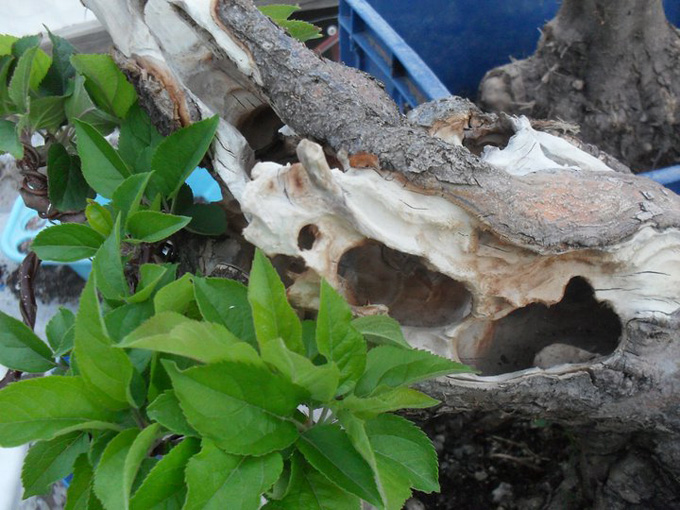
Uruguay anyone? Do this and the other trees in this post, reflect a regional or local bonsai style? (from facebook; Andres Bicocca wall photos.) Correction: Andres is from Argentina.
An open question
Though there are no doubt styles that develop around certain teachers and certain types of trees, and in some cases there are certainly cultural influences (Japan seems the most obvious here), still, pinning down what you might call a local style may not be all that easy. You and your next door neighbor may have quite different approaches to bonsai and your trees might bear little resemblance to each other. Still, you sometimes hear and see reference to local, regional and especially national bonsai styles.
Insecurity?
Some of the discussion about local or regional styles could be a reflection of insecurity and a desire to distinguish ourselves from the Japanese. For years North American bonsai (for example) clearly had a ways to go when compared to Japanese bonsai, so many of us have been looking for the day when we can say that American bonsai has found its own way and is on equal footing with Japanese bonsai (or European bonsai for that matter). This desire seems somewhat natural, but sometimes desire can cloud our vision.
Just saying (as they say)…
I won’t say more. Anyone else?
 A very impressive
A very impressive European olive by way of Uruguay. Another of Andres’ trees . Does it reflect something South American, or Uruguayan? (Whoops, not even close, it’s a Phemphis acidula and it’s from Wild Bonsai – see comments)
 More Andres’ trees. Can you see any thing different or not different about these when compared with olive bonsai from Spain for example (see below). And, if they are different, does it say anything about regional styles, or is it just a personal thing?
More Andres’ trees. Can you see any thing different or not different about these when compared with olive bonsai from Spain for example (see below). And, if they are different, does it say anything about regional styles, or is it just a personal thing?
 A little detour to Spain. This one is by David Benavente, a well-known Spanish bonsai artist. It’s from an earlier Bonsai Bark post.
A little detour to Spain. This one is by David Benavente, a well-known Spanish bonsai artist. It’s from an earlier Bonsai Bark post.
Bonsai Styles of the World, by Charles Ceronio is available at Stone Lantern. Retail 45.00, our low price 36.00

Perhaps “Locally Influenced” would be more accurate. The junipers high on the mountains in central Taiwan weather and grow in a considerably different environment than the larches of New Brunswick. The images presented in the trees from Uruguay are that of wonderful, convincing bonsai. Then again, perhaps ” Influenced” could be applied to any specific tree, regardless of where that tree resides. Sitting in the US, I can carve and shape a tree to appear to be from any given region – provided I have sufficient information or experience of that region to draw upon.
I think DaveP’s last line starts to capture this for me… “provided I have sufficient information or experience of that region to draw upon.” I believe this is what causes bonsai from Japan to differ from Europe and Europe from the USA. In deed, within the US, I think those of us in the East have trouble creating convincing Jin and shari because trees here are more likely to rot away than they do in the arid Western States. I know when I finally do complete an interesting tree with lots of dead wood … my Bonsai Friends will love it, but the neighbors here have never seen a tree that looks like that and actually would rate my much simpler more formal trees higher.
‘Locally’ Influenced’ is accurate where local growing conditions create a growing pattern different from well known habits and which can then be replicated. ‘Local Styles’ are highly indicative where plants native to an area grow in ways different from traditional styles. Many ‘native lovers’ in Australia are working to get recognition for our unique plant growing styles where many native plants do not have the growth habits of well known species. Charles Ceronio has pointed this out very clearly in his fabulous book ‘Bonsai Styles of the World’. Maybe in some future time there will also be ‘Australian Bonsai Styles’. As bonsai spreads out to all corners of the globe and encompasses plant material not native to Japan and China there will have to be recognised national/regional styling differences.
Local growing conditions and species are only part of the story. Look again at the olives from Uruguay and Spain and you’ll see that the do indeed have a lot in common. First, they are similar material, parts of the nebari of what were much larger and extremely old trees that have long since fallen apart and left just a ring of sprouting root remnants. They are not influenced at all by ancient olives because olives simply don’t grow like that. They are in fact the artists’ responses to the material. They are brilliant works of pure fantasy.
But there is something else: both artists are of Spanish descent, they both have the Spanish flamboyance and the confidence and freedom of spirit to express it. You can feel the swirling flamenco dancers in the works of both. David’s reflects more the sophistication of Madrid, while Andres’ reflect perhaps the more ethereal Uruguayan culture. Transplant either of them to Maine and give them yamadori larch – quite different in nature, and their results would still be similar to each other and would still reflect their Spanish roots.
In North America this unity of national cultural influence doesn’t – can never – exist. In part because of all the immigrant groups who still hold on to remnants of their ethnic origins; but importantly, Americans don’t grow up surrounded by a couple of thousand years of cultural and artistic heritage to give them a common emotional expression. Chasing after a national or local style in a multi-cultural society is futile. Looking for cultural styles within that society might be more fruitful.
Thanks DaveP, Rick Marsh, LeeW and Colin,
Great conversation. I was waiting for someone to say something about cultural influences, thinking that I might have to do it myself, but then Colin spared me.
Hi, thanks for put on your website my photos, I am from Argentina.
http://www.oleabonsai.com
I live in Argentina, started to do bonsai eight years ago, I use the deadwood technique to model bonsai.
Workshops demostrations:
Wood:
Features. Carving technics. Wood preservation. Tools; like cutting bits, grinding discs, brushes.
How to create textures in wood. Modeling; especially in straight logs. Aging the bark.
MY POINT OF VIEW OF DESIGNING A BONSAI
Many people make bonsai following steps or rules written in books; books
of great teachers who scored a point in the way of bonsai, somo of wich I
read once, well… if you spend your life doing what those books mark, I
think you will achieve to make a replica of those bonsai that appear in the
books… wich is not bad, on the contrary, but you would not be creating
anything, you will be coping something from someone who knew much.
But art is evolving and to evolve it is clear that we muste be free and not be
tie to rules, looks for new things, leave a little side triangulation, the
balance, the percentages, etc; of course always being rational, when I see
pictures of trees (not bonsai) trees really do not see any of these rules, at
least in the kind of trees I am looking for my inspiration.
The plant that I share with you in this article, is a different plant,
particularly, it had thousands of possible desings, I hope you like it and
enjoy it.
Andres Bicocca
Thanks Andres,
Apologies for placing you in the wrong country. I picked up the Uruguayan notice from here: http://www.facebook.com/photo.php?fbid=10150103125549026&set=a.457202924025.258856.831649025&type=1&theater
My mistake.
Thanks again Andres,
Agreed, books are useful, but bonsai art (or any art) isn’t just about what we learn from books.
no problem, this is an advertisement for a workshop I gave in Uruguay:)
I’m glad you think so, if you need anything let me know.
greetings and thank you very much
“A very impressive European olive by way of Uruguay. Another of Andres’ trees . Does it reflect something South American, or Uruguayan?”
Well, the tree in question is meither an olive nor it lives in South America. This tree is a Pemphis Acidula, which won a top award at the fourth Phillipine Bonsai Association National show. Also, it does not belong nor was created by Andre. You can see more pictures of this tree at http://www.wildbonsai.com , a Filipino site. Also, look closely at the foot of the picture, you’ll see the sie caption.
Warm regards,
Jose Luis
exactly, this plant is not mine, plus there are also pictures of an apple mine, if you want to see my olive http://andresbicocca.blogspot.com/
and in Uruguay there are no olive trees … I AM FROM ARGENTINA MENDOZA.
THE FIRST PHOTO IS MY OLMO, Mendoza is a province planted with olive trees and grapevines. REPEAT IS NOT URUGUAY ARGENTINA!
Thanks again Andres,
Got your message the first time just didn’t get around to correcting it (I’m actually on vacation now). I’ll do it now.
Thanks again,
Ahh Jose,
My editor!
Bad guess on my part. Thanks for the info.